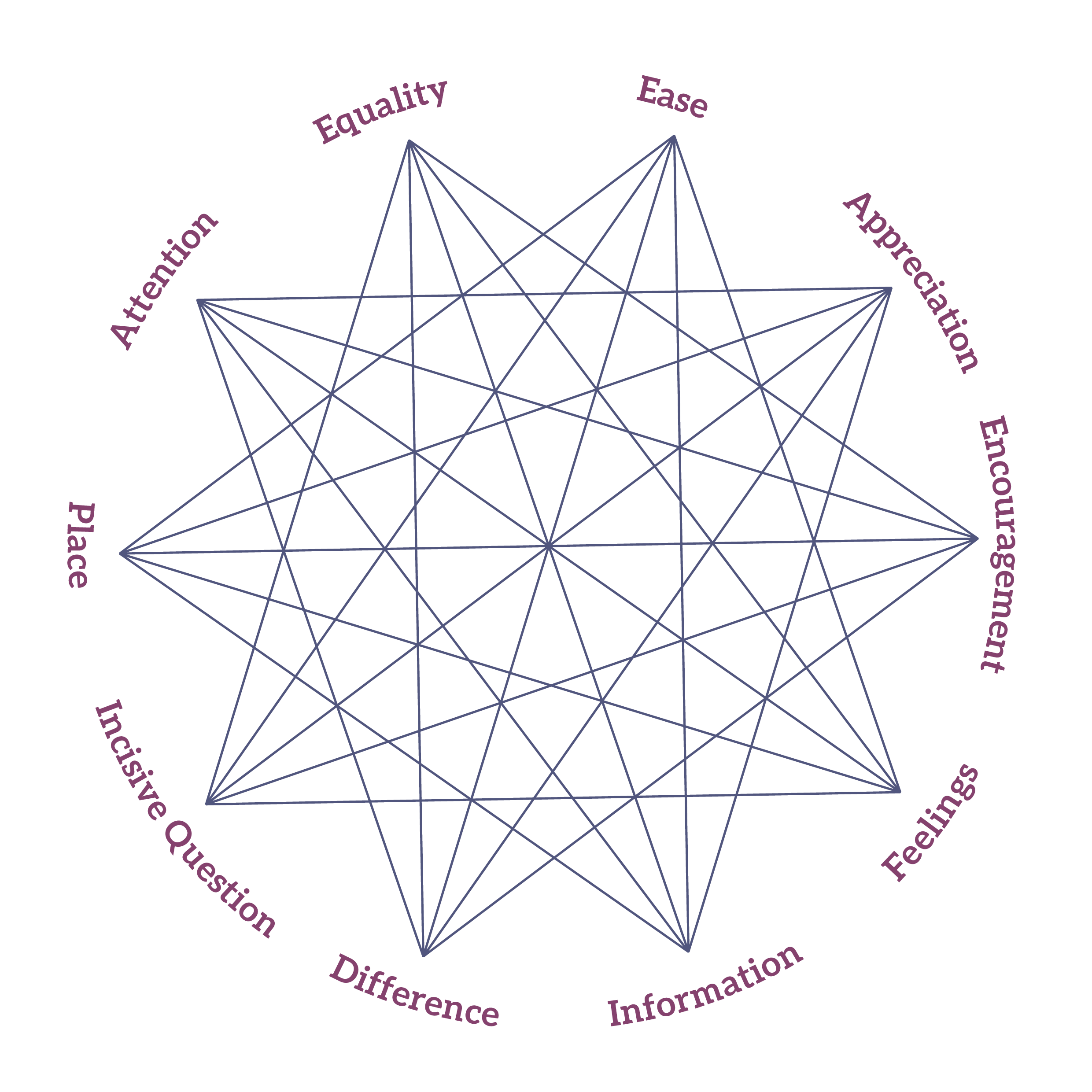TIME TO THINK
Ten Components of a Thinking Environment®
The ten behaviours that generate the finest thinking
The quality of everything we do depends on the quality of the thinking we do first. The quality of our thinking depends on the way we treat each other while we are thinking.
The ten behaviours that generate the finest thinking, and have become known as The Ten Components of a Thinking Environment, are: Attention, Equality, Ease, Appreciation, Encouragement, Feelings, Information, Diversity, Incisive Questions, Place.
Each Component is powerful individually, but the presence of all ten working together gives this process its transformative impact.

ATTENTION
Attention is an act of creation
The quality of our attention determines the quality of other people’s thinking. Attention, driven by the promise of no interruption, and by respect and interest in where people will go with their thinking, is the key to a Thinking Environment. Attention is that powerful. It generates thinking. It is an act of creation.
Attention: listening without interruption and with interest in where the person will go next in their thinking
EQUALITY
Even in a hierarchy people can be equal as thinkers
In a Thinking Environment everyone is valued equally as a thinker. Everyone gets a turn to think out loud and a turn to give attention. To know you will get your turn to speak makes your attention more genuine and relaxed. It also makes your speaking more succinct.
Equality keeps the talkative people from silencing the quiet ones. And it requires the quiet ones to contribute their own thinking. The result is high quality ideas and decisions.
Equality: regarding each other as thinking peers, giving equal time to think
EASE
Ease creates; urgency destroys
Ease, an internal state free from rush or urgency, creates the best conditions for thinking.
But Ease, particularly in organisations and through the ‘push’ aspect of social networking, is being systematically bred out of our lives. if we want people to think well under impossible deadlines and inside the injunctions of ‘faster, better, cheaper, more,’ we must cultivate internal ease.
Ease: discarding internal urgency
APPRECIATION
The human mind works best in the presence of appreciation
In life we learn that to be appreciative is to be naïve, whereas to be critical is to be realistic.
In discussions, therefore, we focus first, and sometimes only, on things that are not working. Consequently, because the brain requires appreciation to work well, our thinking is often specious.
The Thinking Environment recognises the right ratio of appreciation to challenge so that individuals and groups can think at their best.
Appreciation: noticing what is good and saying it
ENCOURAGEMENT
To be ‘better than’ is not necessarily to be ‘good’
To compete does not ensure certain excellence. It merely ensures comparative success. Therefore, competition between thinkers can be dangerous. It can keep their attention on each other as rivals, not on the huge potential for each to think courageously for themselves.
A Thinking Environment prevents internal competition among colleagues, replacing it with a wholehearted, unthreatened search for good ideas.
Encouragement: giving courage to go to the unexplored edge of thinking by ceasing competition as thinkers
FEELINGS
Unexpressed feelings can inhibit good thinking
Thinking stops when we are upset. But if we express feelings just enough, thinking re-starts. Unfortunately, we have this backwards in our society. We think that when feelings start, thinking stops. When we assume this, we interfere with exactly the process that helps a person to think clearly again.
If instead, when people show signs of feelings, we relax and welcome them, good thinking will resume.
Feelings: welcoming the release of emotion
INFORMATION
Full and accurate information results in intellectual integrity
Recognising our collective social context creates psychological safety
Facing what we have been denying leads to better thinking
We base our decisions on information all of the time. When the information is incorrect or limited, the quality of our thinking suffers. Whereas, accurate and full information provides the path to good independent thinking.
Similarly, dismantling denial is often the first step to independent thinking.
Information: absorbing the facts (data, social context, denial)
DIFFERENCE
The greater the diversity of the group, and the greater the welcoming of different points of view, the greater the chance of accurate, cutting-edge thinking
Reality is diverse. Therefore, to think well we need to be in as real, as diverse, a setting as possible.
We need to be surrounded by people from many identity groups, and we need to know that there will be no reprisal for thinking differently from the rest of the group.
Difference: championing our inherent diversity of identity and thought
INCISIVE QUESTIONS TM
A wellspring of good ideas lies just beneath an untrue limiting assumption
An Incisive Question will remove it, freeing the mind to think afresh
The key block to high-quality independent thinking is an untrue limiting assumption, lived as true. To free the mind, therefore, we need to know how to construct an Incisive Question, a tool of unbelievable precision and power.
Incisive Questions: freeing the human mind of untrue assumptions lived as true
PLACE
When the physical environment affirms our importance, we think more clearly and boldly
When our bodies are cared for and respected, our thinking improves
Thinking Environments are places that say back to people, ‘You matter.’ People think at their best when they notice that the place reflects their value to the people there and to the event.
And because the first place of thinking is the body, it needs to be in a condition that says to us as thinkers, ‘You matter’.
In these ways, Place is a silent form of appreciation.
Place: Producing a physical environment – the room, the listener, your body – that says, ‘You matter’